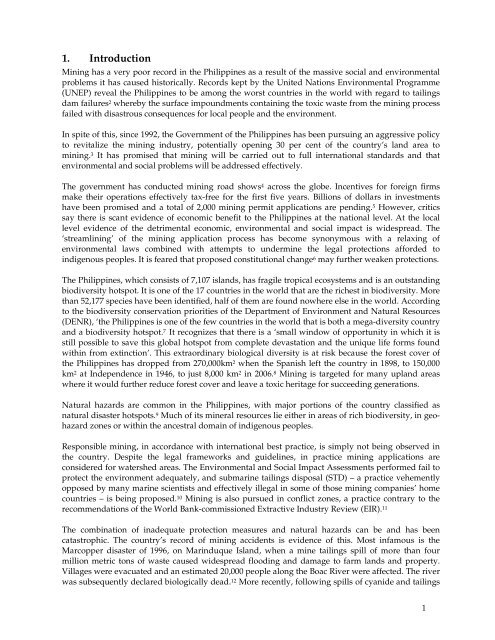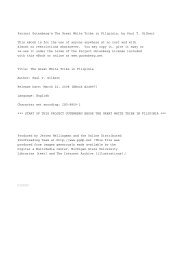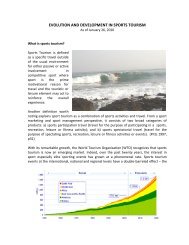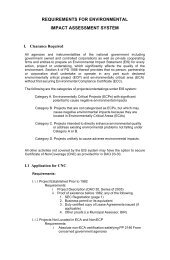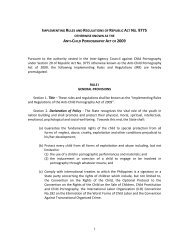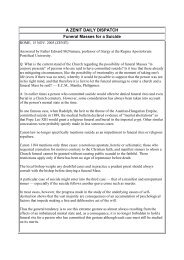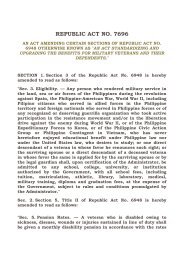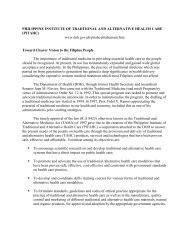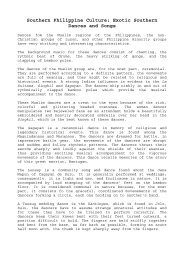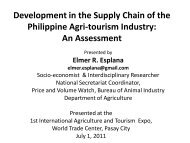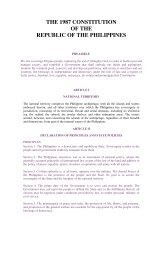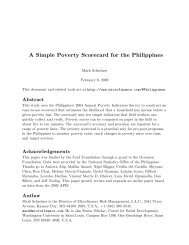Mining in the Philippines - Concerns and Conflicts
Mining in the Philippines - Concerns and Conflicts
Mining in the Philippines - Concerns and Conflicts
Create successful ePaper yourself
Turn your PDF publications into a flip-book with our unique Google optimized e-Paper software.
1. Introduction<br />
<strong>M<strong>in</strong><strong>in</strong>g</strong> has a very poor record <strong>in</strong> <strong>the</strong> Philipp<strong>in</strong>es as a result of <strong>the</strong> massive social <strong>and</strong> environmental<br />
problems it has caused historically. Records kept by <strong>the</strong> United Nations Environmental Programme<br />
(UNEP) reveal <strong>the</strong> Philipp<strong>in</strong>es to be among <strong>the</strong> worst countries <strong>in</strong> <strong>the</strong> world with regard to tail<strong>in</strong>gs<br />
dam failures 2 whereby <strong>the</strong> surface impoundments conta<strong>in</strong><strong>in</strong>g <strong>the</strong> toxic waste from <strong>the</strong> m<strong>in</strong><strong>in</strong>g process<br />
failed with disastrous consequences for local people <strong>and</strong> <strong>the</strong> environment.<br />
In spite of this, s<strong>in</strong>ce 1992, <strong>the</strong> Government of <strong>the</strong> Philipp<strong>in</strong>es has been pursu<strong>in</strong>g an aggressive policy<br />
to revitalize <strong>the</strong> m<strong>in</strong><strong>in</strong>g <strong>in</strong>dustry, potentially open<strong>in</strong>g 30 per cent of <strong>the</strong> country’s l<strong>and</strong> area to<br />
m<strong>in</strong><strong>in</strong>g. 3 It has promised that m<strong>in</strong><strong>in</strong>g will be carried out to full <strong>in</strong>ternational st<strong>and</strong>ards <strong>and</strong> that<br />
environmental <strong>and</strong> social problems will be addressed effectively.<br />
The government has conducted m<strong>in</strong><strong>in</strong>g road shows 4 across <strong>the</strong> globe. Incentives for foreign firms<br />
make <strong>the</strong>ir operations effectively tax-free for <strong>the</strong> first five years. Billions of dollars <strong>in</strong> <strong>in</strong>vestments<br />
have been promised <strong>and</strong> a total of 2,000 m<strong>in</strong><strong>in</strong>g permit applications are pend<strong>in</strong>g. 5 However, critics<br />
say <strong>the</strong>re is scant evidence of economic benefit to <strong>the</strong> Philipp<strong>in</strong>es at <strong>the</strong> national level. At <strong>the</strong> local<br />
level evidence of <strong>the</strong> detrimental economic, environmental <strong>and</strong> social impact is widespread. The<br />
‘streaml<strong>in</strong><strong>in</strong>g’ of <strong>the</strong> m<strong>in</strong><strong>in</strong>g application process has become synonymous with a relax<strong>in</strong>g of<br />
environmental laws comb<strong>in</strong>ed with attempts to underm<strong>in</strong>e <strong>the</strong> legal protections afforded to<br />
<strong>in</strong>digenous peoples. It is feared that proposed constitutional change 6 may fur<strong>the</strong>r weaken protections.<br />
The Philipp<strong>in</strong>es, which consists of 7,107 isl<strong>and</strong>s, has fragile tropical ecosystems <strong>and</strong> is an outst<strong>and</strong><strong>in</strong>g<br />
biodiversity hotspot. It is one of <strong>the</strong> 17 countries <strong>in</strong> <strong>the</strong> world that are <strong>the</strong> richest <strong>in</strong> biodiversity. More<br />
than 52,177 species have been identified, half of <strong>the</strong>m are found nowhere else <strong>in</strong> <strong>the</strong> world. Accord<strong>in</strong>g<br />
to <strong>the</strong> biodiversity conservation priorities of <strong>the</strong> Department of Environment <strong>and</strong> Natural Resources<br />
(DENR), ‘<strong>the</strong> Philipp<strong>in</strong>es is one of <strong>the</strong> few countries <strong>in</strong> <strong>the</strong> world that is both a mega-diversity country<br />
<strong>and</strong> a biodiversity hotspot. 7 It recognizes that <strong>the</strong>re is a ‘small w<strong>in</strong>dow of opportunity <strong>in</strong> which it is<br />
still possible to save this global hotspot from complete devastation <strong>and</strong> <strong>the</strong> unique life forms found<br />
with<strong>in</strong> from ext<strong>in</strong>ction’. This extraord<strong>in</strong>ary biological diversity is at risk because <strong>the</strong> forest cover of<br />
<strong>the</strong> Philipp<strong>in</strong>es has dropped from 270,000km 2 when <strong>the</strong> Spanish left <strong>the</strong> country <strong>in</strong> 1898, to 150,000<br />
km 2 at Independence <strong>in</strong> 1946, to just 8,000 km 2 <strong>in</strong> 2006. 8 <strong>M<strong>in</strong><strong>in</strong>g</strong> is targeted for many upl<strong>and</strong> areas<br />
where it would fur<strong>the</strong>r reduce forest cover <strong>and</strong> leave a toxic heritage for succeed<strong>in</strong>g generations.<br />
Natural hazards are common <strong>in</strong> <strong>the</strong> Philipp<strong>in</strong>es, with major portions of <strong>the</strong> country classified as<br />
natural disaster hotspots. 9 Much of its m<strong>in</strong>eral resources lie ei<strong>the</strong>r <strong>in</strong> areas of rich biodiversity, <strong>in</strong> geohazard<br />
zones or with<strong>in</strong> <strong>the</strong> ancestral doma<strong>in</strong> of <strong>in</strong>digenous peoples.<br />
Responsible m<strong>in</strong><strong>in</strong>g, <strong>in</strong> accordance with <strong>in</strong>ternational best practice, is simply not be<strong>in</strong>g observed <strong>in</strong><br />
<strong>the</strong> country. Despite <strong>the</strong> legal frameworks <strong>and</strong> guidel<strong>in</strong>es, <strong>in</strong> practice m<strong>in</strong><strong>in</strong>g applications are<br />
considered for watershed areas. The Environmental <strong>and</strong> Social Impact Assessments performed fail to<br />
protect <strong>the</strong> environment adequately, <strong>and</strong> submar<strong>in</strong>e tail<strong>in</strong>gs disposal (STD) – a practice vehemently<br />
opposed by many mar<strong>in</strong>e scientists <strong>and</strong> effectively illegal <strong>in</strong> some of those m<strong>in</strong><strong>in</strong>g companies’ home<br />
countries – is be<strong>in</strong>g proposed. 10 <strong>M<strong>in</strong><strong>in</strong>g</strong> is also pursued <strong>in</strong> conflict zones, a practice contrary to <strong>the</strong><br />
recommendations of <strong>the</strong> World Bank-commissioned Extractive Industry Review (EIR). 11<br />
The comb<strong>in</strong>ation of <strong>in</strong>adequate protection measures <strong>and</strong> natural hazards can be <strong>and</strong> has been<br />
catastrophic. The country’s record of m<strong>in</strong><strong>in</strong>g accidents is evidence of this. Most <strong>in</strong>famous is <strong>the</strong><br />
Marcopper disaster of 1996, on Mar<strong>in</strong>duque Isl<strong>and</strong>, when a m<strong>in</strong>e tail<strong>in</strong>gs spill of more than four<br />
million metric tons of waste caused widespread flood<strong>in</strong>g <strong>and</strong> damage to farm l<strong>and</strong>s <strong>and</strong> property.<br />
Villages were evacuated <strong>and</strong> an estimated 20,000 people along <strong>the</strong> Boac River were affected. The river<br />
was subsequently declared biologically dead. 12 More recently, follow<strong>in</strong>g spills of cyanide <strong>and</strong> tail<strong>in</strong>gs<br />
1


